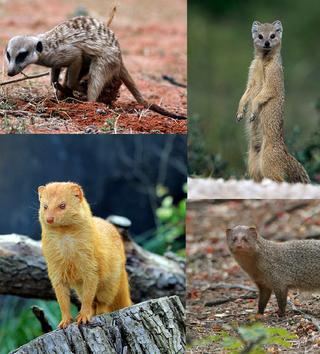
A mongoose is a small terrestrial carnivorous mammal belonging to the family Herpestidae. This family is currently split into two subfamilies, the Herpestinae and the Mungotinae. The Herpestinae comprises 23 living species that are native to southern Europe, Africa and Asia, whereas the Mungotinae comprises 11 species native to Africa. The Herpestidae originated about 21.8 ± 3.6 million years ago in the Early Miocene and genetically diverged into two main genetic lineages between 19.1 and 18.5 ± 3.5 million years ago.
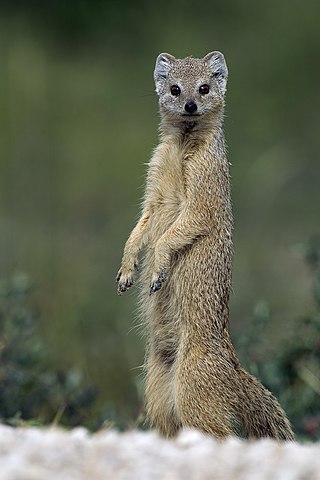
The yellow mongoose, sometimes referred to as the red meerkat, is a member of the mongoose family. It averages about 0.45 kg (1 lb) in weight and about 510 mm (20 in) in length. It lives in open country, semi-desert scrubland and grasslands in Angola, Botswana, South Africa, Namibia, and Zimbabwe. It is the only species in the genus Cynictis.

The marsh mongoose, also called water mongoose is a medium-sized mongoose species native to sub-Saharan Africa that inhabits freshwater wetlands. It has been listed as Least Concern on the IUCN Red List since 2008.

The stripe-necked mongoose is a mongoose species native to forests and shrublands from southern India to Sri Lanka.
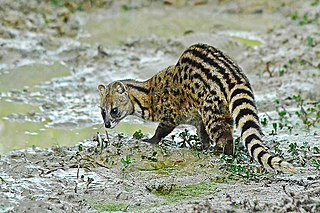
The small Indian civet is a civet native to South and Southeast Asia. It is listed as Least Concern on the IUCN Red List because of its widespread distribution, widespread habitat use and healthy populations living in agricultural and secondary landscapes of many range states.
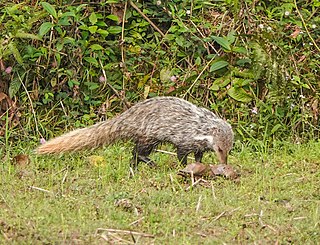
The crab-eating mongoose is a mongoose species ranging from the northeastern Indian subcontinent and Southeast Asia to southern China and Taiwan. It is listed as Least Concern on the IUCN Red List.

The Egyptian mongoose, also known as ichneumon, is a mongoose species native to the tropical and subtropical grasslands, savannas, and shrublands of Africa and around the Mediterranean Basin in North Africa, the Middle East and the Iberian Peninsula. Whether it is introduced or native to the Iberian Peninsula is in some doubt. Because of its widespread occurrence, it is listed as Least Concern on the IUCN Red List.

The golden palm civet is a viverrid endemic to Sri Lanka. It is listed as Vulnerable on the IUCN Red List. Its distribution is severely fragmented, and the extent and quality of its habitat in Sri Lanka's hill regions are declining.
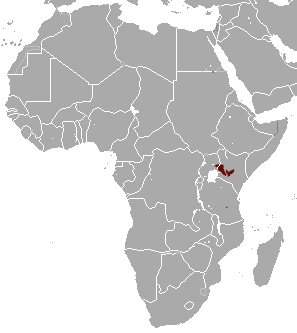
Jackson's mongoose is a mongoose species native to montane forests in Kenya, Uganda and Tanzania. It appears to be rare and has been classified as Near Threatened since 2008.
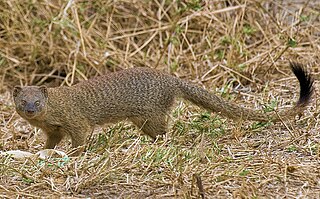
The common slender mongoose, also known as the black-tipped mongoose or the black-tailed mongoose, is a very common mongoose species native to sub-Saharan Africa.

The Indian brown mongoose or brown mongoose is a mongoose species native to the Western Ghats in India and the western coast in Sri Lanka and introduced to Fiji. It is listed as least concern on the IUCN Red List.
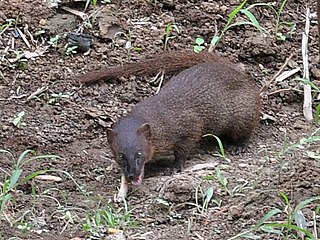
The Javan mongoose is a mongoose species native to Southeast Asia.

The ruddy mongoose is a mongoose species native to hill forests in India and Sri Lanka.

The white-tailed mongoose is a species in the mongoose family Herpestidae. It is the only member of the genus Ichneumia.

Herpestes is a genus within the mongoose family Herpestidae. Several species in the family are known as slender mongooses. It is the type genus of the family, and comprises 5-6 living species, each with several subspecies. Fossil remains of three prehistoric species were excavated in France, and described in 1853.

Alaungdaw Kathapa National Park is a national park in Myanmar covering 541.6 sq mi (1,403 km2). It was established in 1989 and is listed as one of the ASEAN Heritage Parks. It spans an elevation of 443–4,380 ft (135–1,335 m) in the Kani and Mingin Townships in Sagaing Region.
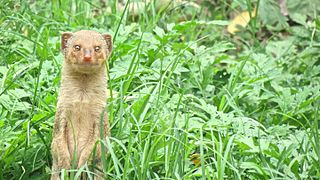
The small Indian mongoose is a mongoose species native to Iraq and northern India; it has also been introduced to several Caribbean and Pacific islands.

Urva is a genus comprising the Asian mongooses within the mongoose family Herpestidae. Species in the genus were formerly classified in the genus Herpestes, which is now thought to comprise exclusively African mongooses; phylogenetic evidence indicates that the Asian mongooses form a monophyletic group and had an Asian common ancestor. Urva forms a clade with Xenogale and Atilax, while Herpestes forms a clade with all other African mongoose species.





















